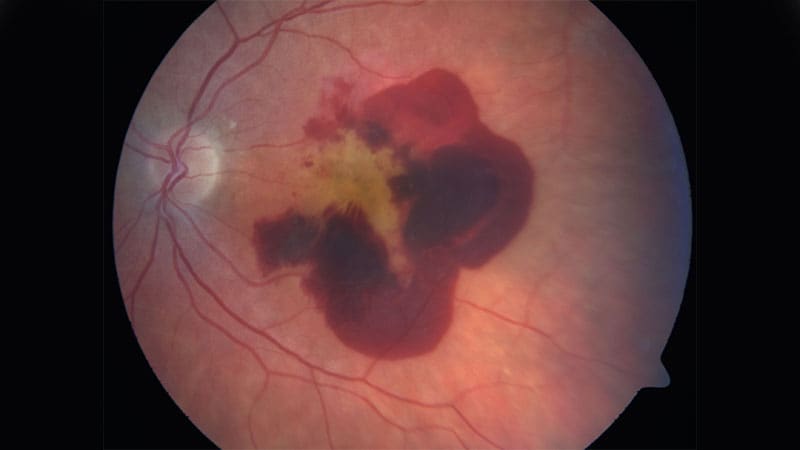Switching to Brolucizumab for Uncontrolled Wet AMD
Concetti Chiave
Switching to brolucizumab can reduce disease activity and improve visual acuity in uncontrolled wet AMD patients.
Sintesi
The content discusses the efficacy of switching to brolucizumab in patients with uncontrolled neovascular age-related macular degeneration (nAMD). The SWIFT study showed promising results in reducing disease activity and improving visual acuity. Key highlights include:
Study leader Ramin Tadayoni presented findings from the SWIFT study at the 2023 annual meeting of the Association for Research in Vision and Ophthalmology.
Patients who switched to brolucizumab after suboptimal responses to first-line agents showed benefits in disease control.
The drug works against vascular endothelial growth factor (VEGF) and has a favorable safety profile.
The study demonstrated improvements in visual acuity and reduction in central subfield thickness (CSFT).
The Australian "Fight Retinal Blindness!" registry also reported positive outcomes with brolucizumab.
Safety concerns, including occlusive vasculitis, were noted, but overall, patients showed good recovery of vision.
Uncontrolled Wet AMD: Drug Switch Can Mute Disease Activity
Statistiche
Patients with no disease activity at 16 weeks: 40%
Mean increase in BCVA from baseline: 4.1 letters
Mean decrease in CSFT: -51 µm
Proportion of patients with no disease activity at week 16: 40.4%
Incidence of dry retina improved from 1.4% at baseline to 31.3% after treatment
Ocular-related adverse events in SWIFT population: 33.9%
Complications like retinal vasculitis and endophthalmitis occurred in 12.9% of participants
Citazioni
"If we can get the patient's exudation under control, as the investigators have nicely demonstrated, there can be an improvement in vision." - SriniVas R. Sadda, MD
"Brolucizumab inactivated most lesions that were previously active." - Mark Gillies, MD
Approfondimenti chiave tratti da
by Caroline Hel... alle www.medscape.com 04-25-2023
https://www.medscape.com/viewarticle/991143
Domande più approfondite
How does the efficacy of brolucizumab compare to other VEGF inhibitors in treating wet AMD
Brolucizumab has shown comparable efficacy to other VEGF inhibitors in treating wet AMD, as evidenced by the SWIFT study presented at the Association for Research in Vision and Ophthalmology 2023 Annual Meeting. Patients who switched to brolucizumab after experiencing suboptimal responses to first-line agents demonstrated a reduction in disease activity and gains in visual acuity. The drug works against vascular endothelial growth factor (VEGF) and has shown outcomes similar to aflibercept, with the added benefit of longer dosing intervals. The study reported a mean increase in best-corrected visual acuity (BCVA) and a decrease in central subfield thickness (CSFT), indicating improved disease control and visual outcomes with brolucizumab.
What are the potential long-term safety implications of using brolucizumab for uncontrolled wet AMD
While brolucizumab has shown promising results in treating uncontrolled wet AMD, there are potential long-term safety implications that need to be considered. The drug has come under scrutiny due to reports of vision loss largely attributed to intraocular inflammation. Safety concerns include ocular-related adverse events, such as retinal vasculitis and endophthalmitis, which occurred in a significant percentage of participants in the SWIFT study. Additionally, cases of occlusive vasculitis resulting in vision loss have been reported. It is crucial to monitor patients closely for signs of inflammation and adverse events to mitigate potential risks associated with brolucizumab treatment.
How can patient monitoring protocols be optimized to detect adverse events early when using brolucizumab
Optimizing patient monitoring protocols is essential to detect adverse events early when using brolucizumab for uncontrolled wet AMD. Given the safety concerns associated with the drug, clinicians should implement rigorous monitoring strategies to ensure patient safety. Regular follow-up appointments should be scheduled to assess visual acuity, disease activity, and signs of inflammation. Ocular-related adverse events, such as retinal vasculitis and endophthalmitis, should be closely monitored and promptly addressed. Educating patients about potential symptoms of adverse events and encouraging them to report any changes in vision or discomfort can aid in early detection. Utilizing imaging techniques and biomarkers to monitor disease activity and response to treatment can also enhance the effectiveness of patient monitoring protocols. By implementing comprehensive and proactive monitoring strategies, clinicians can detect adverse events early and optimize patient outcomes when using brolucizumab for uncontrolled wet AMD.
0
